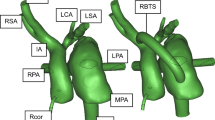Abstract
Transposition of the great arteries is functionally corrected by Mustard’s operation, an operation in which the atrial septum is removed and the resulting common atrial chamber repartitioned by a baffle to transpose venous return to the heart. To better understand the new physiology, a physically-based mathematical model of the infant circulation following Mustard’s operation was developed and studied with the aid of computer simulation. The model reproduces certain clinical observations, including the tendency for mean pressure in both atria to be equal early postoperatively and for the pressure waveform to exhibit a steep y-descent in the systemic venous atrium. Simulation studies suggest that the mechanism for the former is transbaffle pressure coupling resulting from dynamic motion of the baffle; the mechanism for the latter is limitation of the extent of such baffle excursions. Dynamic volume of the two atria is found in the model to change according to the relative performance of the two ventricles, and stiffening the baffle leads to pressure waveforms characteristic of a small, noncompliant atrium. Mechanisms for venous “obstruction” and decompression were also studied. The baffle and its movements, however, have little effect upon cardiac output in the model, leaving unexplained the clinical observation of low output early postoperatively.
Similar content being viewed by others
Abbreviations
- SVA:
-
Systemic venous atrium, that portion of the atrium partitioned so as to receive desaturated systemic venous blood; it empties through the mitral valve into the morphological left ventricle (which, due to the transposed great arteries, is the pulmonary ventricle)
- IVL:
-
Inferior portion (leg) of SVA, receiving blood from the inferior vena cava
- SVL:
-
Superior portion (leg) of SVA, receiving blood from the superior vena cava
- PVA:
-
Pulmonary venous atrium, that portion of the atrium partitioned so as to receive oxygenated pulmonary venous blood; it empties through the tricuspid valve into the right ventricle (which, due to the transposed great arteries, is the systemic ventricle)
- SVC:
-
Superior vena cava
- IVC:
-
Inferior vena cava
- SV:
-
Systemic ventricle, the morphological right ventricle into which the PVA empties oxygenated blood, and which faces systemic (aortic) pressures du to the transposed great arteries
- PV:
-
Pulmonary ventricle, the morphological left ventricle into which the SVA empties desaturated blood, and which faces pulmonic (pulmonary artery) pressures due to the tricuspid great arteries
References
Beneken, J.E.W.Cardiovascular Fluid Dynamics. London: Academic Press, 1972, pp. 163–213.
Berglund, E. Ventricular function. VI. Balance of left and right ventricular output: Relation between left and right atrial pressures.Am. J. Physiol. 178:381–386, 1954.
Blackstone, E.H., A.K. Gupta, and V.C. Rideout. Cardiovascular simulation study of infants with transposition of the great arteries after surgical correction.Math. Comput. Simulat. 19:39–50, 1977.
Breckenridge, I.M., J. Stark, R.E Bonham-Cater, H. Oelert, G.R. Graham, and D.J. Waterston, Mustard’s operation for transposition of the great arteries: Review of 200 cases.Lancet 1(2): 1140–1142, May 27, 1972.
Hagler, D.J., A.J. Tajik, and D.G. Ritter. Fluttering of atrioventricular valves in patients with d-transposition of the great arteries after Mustard operation.Mayo Clin. Proc. 50:69–75, 1975.
House, P.W. and J. McLeod.Large-scale Models for Policy Evaluation. New York: John Wiley and Sons, 1977.
Kuchar, N.R. Fluid dynamics in flexible tubes: An application to the study of the pulmonary circulation. NASA Annual Report, Contract No. NASW-2138, 1971.
Lau, V-K. and K. Sagawa. Model analysis of the contribution of atrial contraction to ventricular filling.Ann. Biomed. Eng. 7:167–201, 1979.
Morgan, J.R., B.L. Miller, G.R. Daicoff, and E.J. Andrews. Hemodynamic and angiocardiographic evaluation after Mustard procedure for transposition of the great arteries.J. Thorac. Cardiovasc. Surg. 64:878–891, 1972.
Mustard, W.T., J.D. Keith, G.A. Trusler, R. Fowler, and L. Kidd. The surgical management of transposition of the great vessels.J. Thorac. Cardiovasc. Surg. 48:953–958, 1964.
Nanda, N.C., S. Stewart, R. Gramiak, and J.A. Manning. Echocardiography of the intra-atrial baffle in dextro-transposition of the great vessels.Circulation 51:1130–1135, 1975.
Parr, G.V.S., E.H. Blackstone, J.W. Kirklin, A.D. Pacifico, and P. Lauridsen. Cardiac performance early after interatrial transposition of venous return in infants and small children.Circulation 49–50(II): 2–8, 1974.
Quaegebeur, J.M., J. Rohmer, and A.G. Brom. Revival of the Senning operation in the treatment of transposition of the great arteries: Preliminary report on recent experience.Thorax 32:517–524, 1977.
Rideout, V.C. and D.E. Dick. Difference-differential equations for fluid flow in distensible tubes.IEEE Trans. Biomed. Eng. BME-14:171–177, 1967.
Rideout, V.C. and C.J. Davis, Simulation of collapsible veins. Proc. 30th Annual Conference on Engineering in Medicine and Biology, November 1977, p. 371.
Senning, A. Surgical correction of transposition of the great vessels.Surgery 45:966–980, 1959.
Shaher, R.M.Complete Transposition of the Great Arteries. New York: Academic Press, 1973.
Silverman, N.H., M. Payot, P. Stanger, and A.M. Rudolph. The echocardiographic profile of patients after Mustard’s operation.Circulation 58:1083–1093, 1978.
Stewart, R.W., J.W. Kirklin, A.D. Pacifico, E.H. Blackstone, and J.M. Bargeron. Repair of double-outlet right ventricle.J. Thorac. Cardiovasc. Surg. 78:502–514, 1979.
Suga, H. Importance of atrial compliance in cardiac performance.Circ. Res. 35:39–43, 1974.
Trusler, G.A., R.C. Bull, T. Hoeksema, and W.T. Mustard. The effect on cardiac output of a reduction in atrial volume.J. Thorac. Cardiovasc. Surg. 46: 109–116, 1963.
Wyse, R.K.H., S.G. Haworth, J.F.N. Taylor, and F.J. Macartney. Obstruction of superior vena caval pathway after Mustard’s repair: Reliable diagnosis by transcutaneous Doppler Ultrasound.Br. Heart J. 42:162–167, 1979.
Wyse, R.K.H., F.J. Macartney, J. Rohmer, J. Ottenkamp, and A.G. Brom. Differential atrial filling after Mustard and Senning repairs: Detection by transcutaneous Doppler Ultrasound.Br. Heart J. 44:692–698, 1980.
Author information
Authors and Affiliations
Additional information
Supported in part by Program Project Grant HL-11310 from the National Heart, Lung, and Blood Institute, Bethesda, Maryland, and Engineering Experiment Station, University of Wisconsin, Madison, Wisconsin.
Rights and permissions
About this article
Cite this article
Blackstone, E.H., Rideout, V.C. & Beduhn, D.L. Simulation analysis of interatrial transposition of venous return (Mustard’s operation). Ann Biomed Eng 10, 193–218 (1982). https://doi.org/10.1007/BF02367393
Issue Date:
DOI: https://doi.org/10.1007/BF02367393




